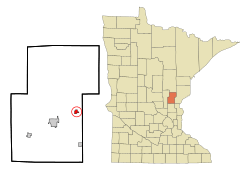Quamba, Minnesota facts for kids
Quick facts for kids
Quamba, Minnesota
|
|
|---|---|

Location of Quamba, Minnesota
|
|
| Country | United States |
| State | Minnesota |
| County | Kanabec |
| Established | 1882 |
| Platted | 1901 |
| Incorporated | July 11, 1952 |
| Area | |
| • Total | 0.704 sq mi (1.822 km2) |
| • Land | 0.704 sq mi (1.822 km2) |
| • Water | 0.000 sq mi (0.000 km2) |
| Elevation | 1,017 ft (310 m) |
| Population
(2020)
|
|
| • Total | 107 |
| • Estimate
(2022)
|
108 |
| • Density | 151.99/sq mi (58.72/km2) |
| Time zone | UTC−6 (Central (CST)) |
| • Summer (DST) | UTC−5 (CDT) |
| ZIP Code |
55007
|
| Area code(s) | 320 |
| FIPS code | 27-52756 |
| GNIS feature ID | 2396296 |
| Sales tax | 7.375% |
Quamba is a small city located in Kanabec County, Minnesota, in the United States. In 2020, about 107 people lived there. Quamba is special because it is the only city in Minnesota whose name starts with the letter "Q"!
Contents
History of Quamba: How the City Got Its Name
Quamba was first started in 1882. It was built next to the tracks of the Great Northern Railway. The area was first known as "Mud Creek." This name came from a creek that flows through the community. The railroad tracks also crossed this creek.
Original Names and Meanings
The Ojibwe people who lived in the area had a different name for the creek. They called it Basa'igani-ziibiwishenh. This means "Creek to square Cedar Timbers." So, they called the community Basa'igani-ziibiwishenying, which means "By the Creek to Square Cedar Timbers."
Why the Name Changed to Quamba
When a train station, called a depot, was built, the name of the community changed to "Quamba." Railway officials said this new name came from an old Native American word for "mudhole." It likely came from the Ottawa word azhashki-wiimbaakamigaa. This word means "be a muddy hole in the ground."
When Quamba Became a Village
The community was officially mapped out in 1901 by Oric Ogilvie Whited. This process is called "platting." Quamba officially became an incorporated village on July 11, 1952. An "incorporated village" means it became an official town with its own local government. The city also had a post office that operated from 1901–1903 and again from 1906–1966.
Geography of Quamba: Where is it Located?
Quamba is a small city in terms of its size. According to the United States Census Bureau, the city covers a total area of about 0.704 square miles (1.822 square kilometers). All of this area is land. There are no large bodies of water within the city limits.
Transportation: Roads That Connect Quamba
Even though Quamba is a small city, it has important roads that pass through it. These roads help people travel to and from the city.
Major Roads Serving Quamba
The main roads that go through Quamba are:
 Minnesota State Highway 23: This is a state highway that connects Quamba to other towns and cities in Minnesota.
Minnesota State Highway 23: This is a state highway that connects Quamba to other towns and cities in Minnesota. Kanabec County Road 5: This is a county road that helps people travel within Kanabec County.
Kanabec County Road 5: This is a county road that helps people travel within Kanabec County.- Kanabec County Road 70: Another county road that serves the area around Quamba.
Demographics: Who Lives in Quamba?
The population of Quamba has changed over the years. Understanding demographics helps us learn about the people who live in a place.
| Historical population | |||
|---|---|---|---|
| Census | Pop. | %± | |
| 1960 | 95 | — | |
| 1970 | 114 | 20.0% | |
| 1980 | 122 | 7.0% | |
| 1990 | 124 | 1.6% | |
| 2000 | 98 | −21.0% | |
| 2010 | 123 | 25.5% | |
| 2020 | 107 | −13.0% | |
| 2022 (est.) | 108 | −12.2% | |
| U.S. Decennial Census 2020 Census |
|||
Population in 2010
In 2010, the census showed that 123 people lived in Quamba. There were 42 households, which are groups of people living together in one home. About 30 of these households were families. The city had about 170 people per square mile.
Most of the people living in Quamba in 2010 were White. A small number were Native American. Some residents were also of Hispanic or Latino background.
Households and Families
In 2010, about 31% of households had children under 18 living with them. Many households were married couples living together. Some households were led by a single parent, either a mother or a father. Other households were made up of individuals or people who were not related.
The average household in Quamba had about 2.93 people. The average family had about 3.23 people.
Age of Residents
The average age of people in Quamba in 2010 was 35.5 years old.
- About 26.8% of residents were under 18 years old.
- About 12.4% were between 18 and 24 years old.
- About 17.2% were between 25 and 44 years old.
- About 30.1% were between 45 and 64 years old.
- About 13.8% were 65 years old or older.
More females lived in Quamba than males in 2010. About 56.9% of the population was female, and 43.1% was male.
See also
 In Spanish: Quamba (Minnesota) para niños
In Spanish: Quamba (Minnesota) para niños

